The SilverStone Fortress FT05 Case Review
by E. Fylladitakis on June 5, 2015 8:00 AM EST- Posted in
- Cases/Cooling/PSUs
- SilverStone
- Case
Test setup
Professional testing requires the emulation of real-world situations but with repeatable results; thus, a perfectly controllable test setup and environment are required, especially for comparable results. Testing the thermal performance of any case with a typical real-world setup technically limits the comparability of the results to this setup alone, as an active system interacts with its environment and the change of a single component would alter myriads of variables.
As such, we developed synthetic loads that emulate the thermal output of real systems, which however are passive, steady and quantifiable. As a result, our thermal testing displays the thermal capabilities of the case alone, as if it would have to deal with the entire thermal load by itself, regardless of the system that would be installed inside it. Laboratory data loggers are being used to monitor the PT100 sensors and control the safety relays, which are fully accessible via our custom software. Three such loads have been developed; the ATX version simulates a 200W CPU, 50W VRM, 30W RAM and 4 × 120W GPU card thermal load. Finally, three 3.5" HDD dummy loads have also been created, with each of them converting 30 W of electrical power to thermal, bringing the total thermal load of the ATX test setup up to 850 Watts. As such, the thermal load is immense and only the best of cases will be able to handle it for more than a few minutes. Meanwhile we are also performing a test with a thermal load of 400W, with all of the aforementioned components except the HDD drives at about 42% power, which is more suitable for the majority of cases.
Thermal testing has been performed with all of the case's stock fan operating at maximum speed. Noise testing has been performed with a background noise level of 30.4dB(A). Advanced noise testing is also being performed, in order to assess the ability of the case to dampen the noise of the components installed inside it. This includes the installation of two noise-generating sources (strong fans) inside the case, one positioned approximately over the first expansion slot and one over the CPU area, which generate ≈ 44.2 dB(A) when unobstructed. During the advanced noise test, all stock cooling options of the case are entirely disabled.
Note: As the Fortress FT05 can only host two 3.5" devices, the maximum load of each test configuration is reduced by 30 Watts (minus one HDD dummy load).
Results and discussion
The thermal performance of the SilverStone Fortress FT05 is just a little worse than that of the Raven RV05. This was to be expected, as the sound dampening material on all panels acts as a thermal insulator as well, forcing nearly all of the heat transfer to take place via the airflow. Still, the thermal performance remains fantastic, rivaling that of much larger and fancier products. Even cases with double the volume of the Fortress FT05 are having a hard time competing. For example, the small and cramped Fortress FT05 can maintain about the same GPU temperatures as the massive Corsair 760T. However, this is solely because there are two massive 180mm intake fans supplying ample air directly over the system. If the airflow is blocked for any reason (e.g. messy cable job, dust on the filter, etc.), the thermal performance of the Fortress FT05 plummets.
With the Raven RV05, the 180mm stock cooling fans had the downside of being significantly loud at maximum speed. The same fans are present in the Fortress FT05 but the sound dampening material makes for a notable drop of the sound pressure levels, making the 180mm fans completely inaudible at low speeds. With a maximum of 37.3dB(A), the Penetrator fans are now fairly comfortable for everyday use even at their maximum speed. Considering the airflow of these fans, running them at half the speed will provide more than adequate airflow to a system with a typical CPU and a single GPU.
The sound dampening capabilities of the Fortress FT05 were better than we initially anticipated. As the top of the case is almost entirely perforated, one would expect the noise dampening capabilities to be very low. SilverStone pleasantly surprised us, with the Fortress FT05 reducing the noise of our dummy test source from 44.2dB(A) to 40.9dB(A). It may not seem as an astonishing figure at first but remember that the decibel scale is logarithmic and seemingly small changes can have great real world repercussions. It actually is very good, with a drop of the sound intensity by nearly 54% (2.63×10-8 to 1.23××10-8 Watts per square meter).


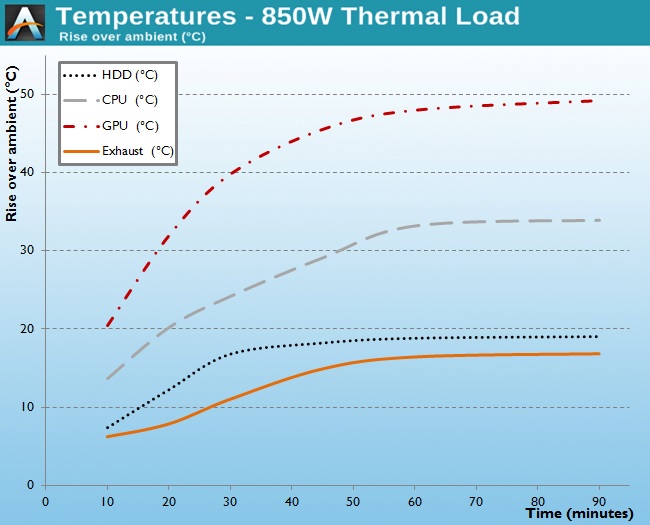
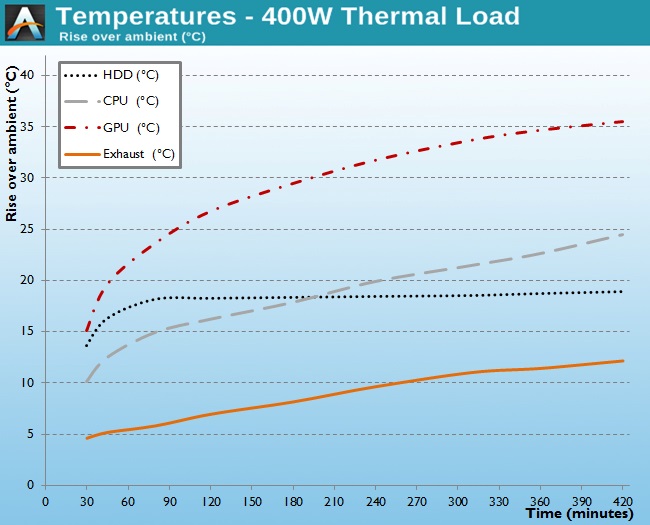
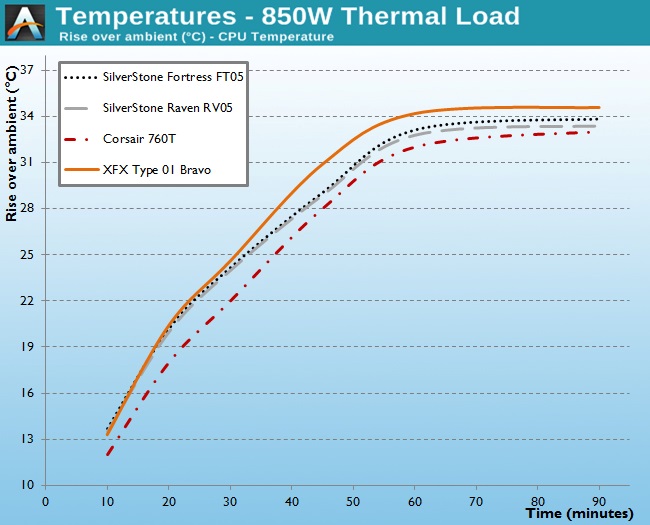
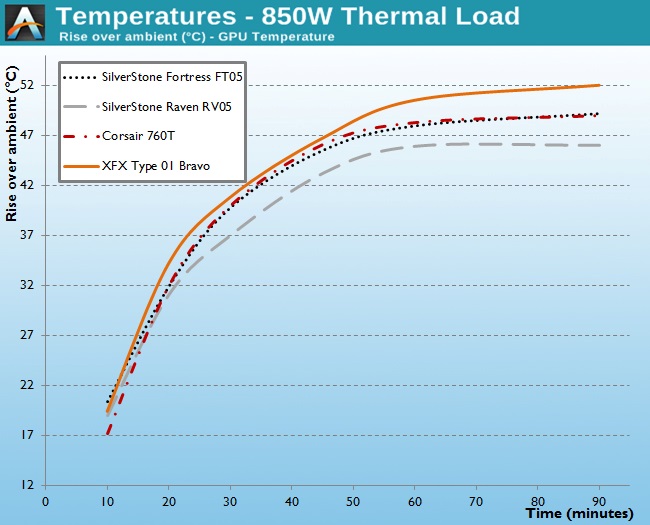
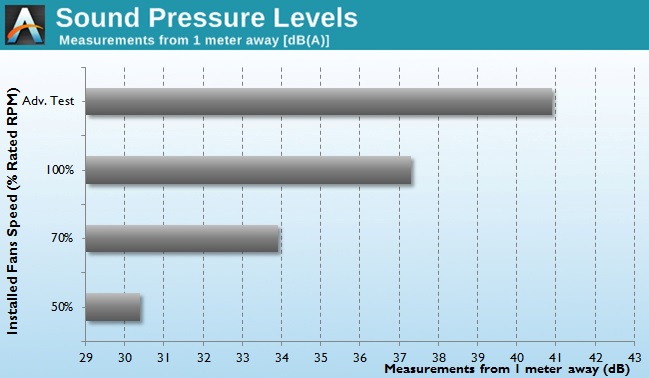








47 Comments
View All Comments
Kepe - Friday, June 5, 2015 - link
Well, a ~$200 case is not exactly meant for the budget crowd, so having to pay $60 extra for a slot-loading DVD/Blu-ray drive (compared to a regular 5.25" drive) isn't going to be a huge issue.. But for me, the interior space is just a little too cramped. I have a Silverstone Raven 03 and it has a lot of room for all the stuff one might need. Of course it's also a lot bigger with tons of 3½" HDD bays, which I don't use at all. I hope Silverstone could find a better compromise between a huge case like the Raven RV03 and the cramped Raven RV05 and Fortress FT05.. They should also think about possibilities with water cooling, as none of these cases have proper space for (bigger than 120mm) radiators without removing the bottom fans which defeats the entire purpose of these cases. On the RV03 for example, the entire rear panel of the case is just blank with one 120mm fan opening, and nothing attached to the panel inside the case. This would be a perfect place for a 280mm radiator, although it is a bit far from the CPU socket and AIO coolers probably don't have long enough hoses to mount the rad there.Anyways, the bottom-to-top airflow of these cases is absolutely awesome keeping everything nice and cool and quiet. I have my fans connected to the MB instead of the fan controller, and the MB controls the fans according to CPU thermals.
Flunk - Friday, June 5, 2015 - link
Or pick up a USB optical drive for $30 and never have to buy another one.cjs150 - Friday, June 5, 2015 - link
"the installation of liquid cooling radiators requires the removal of the 180mm Penetrator fans "There are radiators designed for 180mm fans. Might be an interesting modding exercise to fit a 2x180mm radiator into this, I think you would need to loose the HDD cage (no big loss) and probably cut the back of the case to allow radiator and barbs to stick out back, then route tubing back through case (maybe have a custom reservoir at case back as well). Looks like it could be done and with right colour scheme would be stunning.
Now all I need to do is build my modding cave to start!
DanNeely - Friday, June 5, 2015 - link
It'd need to be a compact design to fit in the case though. A standard radiator layout with only fins/channels in the path of the fan and an inch or two of overhang on both sides to connect the water channels and hoses wouldn't fit because there's almost no clearance on either side of the fans. It doesn't look like you'd have much space for overhang on the long sides either; but from the pictures I can't tell if it'd be tight enough to be a potential problem. Honestly, I think a bracket to put a 280 rad on top of the existing fans would probably be the best option.DanNeely - Friday, June 5, 2015 - link
Whoops, I intended this as a reply to Kepe (above) who wasn't thinking in terms of cutting the case up to make things fit.cjs150 - Friday, June 5, 2015 - link
DanNeely: I think you are right about the width which makes things a bit awkward, keeping the fans where they are and a custom shroud between fan and radiator is a nice idea - there is definitely the option of a stunning liquid cooled build with this case.I have never had a problem with pump vibration using proper isolation material solves the problem.
Cutting up case is half the fun of modding !
Primum - Friday, June 5, 2015 - link
While you'd probably not fit the EK dual 180 in (400x180x35) without some difficulty, I can't see any reason you wouldn't fit the Alphacool one in easily enough. With the fans at the bottom in push it's fairly straight forward. At a stretch a custom shroud would work, but you run the risk of making your cable management job even harder than it already is.Boffinboy - Friday, June 5, 2015 - link
This is a fairly common mod for the FT-02. I did so with mine, but used a 3x180mm and a 120mm at the top. Requires removing the built in fan filter (I replaced mine with a DEMCIflex magnet filter externally) and some cutting depending on the loop you build. The 2x180mm requires no dremeling, particularly if you get a thin version.My loop got infected and I ended up deciding to go back to a large air cooler for the CPU and not bothering to put my graphics cards under water. In all honesty the performance under air is fine, and just as quiet - I had a bay res and the pump vibration was noticeable. An expensive experiment that was!
I'd be very tempted by this FT-05, but it's so costly, and I'm not sure anyone would buy my hacked-up FT-02...
alaricljs - Friday, June 5, 2015 - link
I've been occasionally working on a design like this for 3-4 years now... I don't think it's very good yet but this one isn't as good as what I've come up with imho...DanNeely - Friday, June 5, 2015 - link
"Breakthrough 5.25 inch bay-free design for unprecedented power to size ratio"*rolls eyes* Because no one has sold a case without 5.25" bays before.